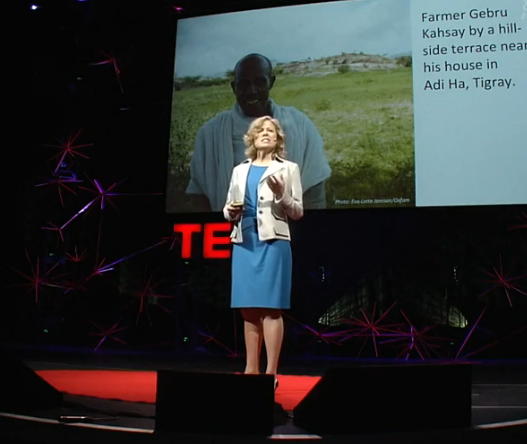I'd like to share three sets of examples, starting with adapting to violent storms and floods.
我想分享三个例子,开始于适应猛烈的暴风雨和洪水。
In New Orleans, the I-10 Twin Spans, with sections knocked out in Katrina,
在新奥尔南,1-10双拱桥因其中一个被击垮,
have been rebuilt 21 feet higher to allow for greater storm surge.
已经重建高21码去适应更猛烈的浪潮。
And these raised and energy-efficient homes
这些建得更高且高能效的房屋
were developed by Brad Pitt and Make It Right for the hard-hit Ninth Ward.
是“布拉特皮特”和“使它变得更好”组织建立的,为了拥有九级防御功能
The devastated church my mom attends has been not only rebuilt higher,
这个被摧毁了的教堂是我母亲过去常去的一个,不仅仅被建得更高了,
it's poised to become the first Energy Star church in the country.
而且还被建成了这个国家的第一个一星能源教堂。
They're selling electricity back to the grid
它们运输电源到输电网
thanks to solar panels, reflective paint and more.
基于太阳能面板和反光漆油以及其余东西。

Their March electricity bill was only 48 dollars.
他们三月份的电费仅仅是48美金。
Now these are examples of New Orleans rebuilding in this way,
现在这些是新奥尔南重建过程中的案例
but better if others act proactively with these changes in mind.
但是如果别人能够提前设想这些措施就更好了。
For example, in Galveston, here's a resilient home that survived Hurricane Ike,
举个例子,在加尔维斯顿有一个弹性结构房从飓风中得以幸存
when others on neighboring lots clearly did not.
当时它周围的建筑都被摧毁殆尽。
And around the world, satellites and warning systems are saving lives in flood-prone areas such as Bangladesh.
与此同时在世界各地,卫星和报警系统正在像孟加拉国这样的低洼地区拯救生命
But as important as technology and infrastructure are,
但是就像技术和基础设施一样重要
perhaps the human element is even more critical.
人为因素可能更为重要。
We need better planning and systems for evacuation.
我们需要更好的疏散计划和系统。
We need to better understand how people make decisions in times of crisis, and why.
我们需要透彻地理解当人们面临危机时,要如何做决定,而且为什么。
While it's true that many who died in Katrina did not have access to transportation,
虽然真相是很多凯瑟琳台风遇害者都未能使用交通工具
others who did refused to leave as the storm approached,
而有机会使用交通工具的却在暴风雨来临时拒绝离开
often because available transportation and shelters refused to allow them to take their pets.
这常常是因为可使用的交通工具和避难所,都不允许他们带上自己的宠物
Imagine leaving behind your own pet in an evacuation or a rescue.
想象一下无法撤离和营救你自己的宠物。
Fortunately in 2006, Congress passed the Pet Evacuation and Transportation Standards Act
但幸运的是在2006年,国会通过了宠物撤离及运输标准法案
it spells "PETS" to change that.
添上了“宠物”,从而改变了之前的情形
Second, preparing for heat and drought.
第二点,为和高温和干旱做好准备
Farmers are facing challenges of drought from Asia to Africa, from Australia to Oklahoma,
农民们正面临着旱灾的挑战,从亚洲到非洲,从澳洲到俄克拉荷马州
while heat waves linked with climate change
与此同时高温热浪和气候变化紧紧相连
have killed tens of thousands of people in Western Europe in 2003, and again in Russia in 2010.
在2003年在西欧和2010年的俄罗斯,已经杀死了成千上万的人。
In Ethiopia, 70 percent, that's 7-0 percent of the population, depends on rainfall for its livelihood.
在埃塞俄比亚百分之七十,是百分之七十的人口,依靠降雨来维持他们的生活。
Oxfam and Swiss Re, together with Rockefeller Foundation,
牛津饥荒救济委员会和瑞士再保险公司与洛克菲勒基金会携手
are helping farmers like this one build hillside terraces and find other ways to conserve water,
共同帮助农民们建造山坡梯田和找寻其余的方法保存用水
but they're also providing for insurance when the droughts do come.
当旱灾来临的时候,他们也提供保险赔偿
The stability this provides is giving the farmers the confidence to invest.
这让那些农民坚定了投资的信心。
It's giving them access to affordable credit.
向他们提供可负担的贷款。
It's allowing them to become more productive so that they can afford their own insurance over time, without assistance.
这使他们变得更加多产,随着时间的流逝,他们有能力自给自足,从而不需要救助。
It's a virtuous cycle, and one that could be replicated throughout the developing world.
这是一个良性循环,而且是可以在发展中国家广泛使用的。



